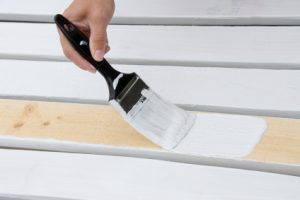 When it comes to woodwork, whether interior or exterior, there are hundreds of options for finishing it using paint or stain. While stains allow the natural character and grain of the wood to show through, paints are supposed to create a smooth, uniform surface that hides the wood beneath. That is why knot-bleed is so frustrating; you spend all those hours prepping and painting your wood item, and then when the paint is dry, unsightly rings and spots appear on the surface. Here is how to paint wood properly to prevent knot-bleeds.
When it comes to woodwork, whether interior or exterior, there are hundreds of options for finishing it using paint or stain. While stains allow the natural character and grain of the wood to show through, paints are supposed to create a smooth, uniform surface that hides the wood beneath. That is why knot-bleed is so frustrating; you spend all those hours prepping and painting your wood item, and then when the paint is dry, unsightly rings and spots appear on the surface. Here is how to paint wood properly to prevent knot-bleeds.
In order to achieve satisfactory results with your painting project, it is important to follow the correct procedure. Though some of the specifics differ, the basic steps are the same whether you are painting wood on antique furniture, outdated cabinets, exterior trim, decks, fences or picnic tables.
Step 1: Clean the surface. If the item you are painting has a previous layer of finish on it, this needs to be deglossed. This can be done by sanding or using a liquid deglosser. If you are working on exterior woodwork such as a deck or trim, pressure washing is a good way to remove contaminants. If painting cabinets, make sure there is no grease from hands or cooking.
Step 2: Create a sound surface. In order for the final paint film to look great, the substrate (under-surface) must be smooth, with no dips, cracks, bumps or flaws. Use a light wood-filler and a putty knife to fill any nicks or cracks. When it is dry, sand the surface smooth.
Step 3: Prime with an alcohol-based Shellac tinted primer. A good primer serves several functions. First, it binds to the wooden surface tightly, creating a new surface that the paint can stick to. Additionally, it seals the pores of the wood so that the paint will not be absorbed unevenly, creating a blotchy appearance. Finally, a primer will stop colors and saps from the wood from bleeding through the surface coat, as often happens around knots.
Step 4: Paint. For best results, use a premium-grade paint that is designed for your location (interior / exterior). You will typically use a brush for this type of work, but a sprayer is also a good option for large surfaces. If your final color is not white, you are likely to want at least two coats for best results.
If you have any questions you’d like answered here, ask us via twitter or Facebook.